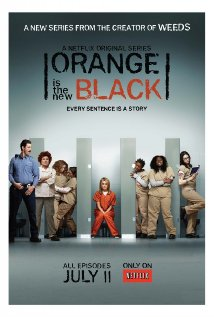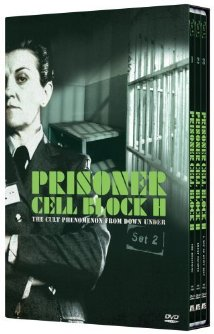Prison, Television and Sexuality
Kate Warner / University of Queensland

Television dramas and comedies set in prison have a reasonably venerable history. Shows have included the classic British comedy Porridge (1973-1978), the Australian soap Prisoner (1979-1986), the American cable drama Oz (1997-2003), and the British soap-drama Bad Girls (1999-2006). This year there has been an Australian remake of Prisoner called Wentworth (2013) and the Netflix comedy/drama Orange Is the New Black (2013).
This column will address how homosexuality has been represented in these programs. Prison shows were among the first to represent gay people and there has been a remarkable continuity of queer characters over a relatively long period of time in a single genre. This has not been the case in any other TV genre. I argue that the representation of queerness in prison shows falls into three time periods, which are indicative of society’s changing attitude to homosexuality.
Prison is rich dramatic territory for TV writers, and romance (particularly gay romance) is one of the most valuable tools in a TV writer’s tool box. Some of the homosexuality represented in prison programs may be there for its titillation value, but given that it is occurring in mostly long-running TV programs, the gay characters tend to be more than tokens and can become reasonably well-rounded.
Prison shows have benefited from a level of freedom in representing queer characters because this is seen as ‘realism.’ In general, prison shows appeal to realism whenever they are presenting matters deemed ‘shocking’ while simultaneously benefiting from the publicity that this brings (Geraghty 1995, 67).1 Realism acts both as titillation and as a defense against accusations of titillation. This is still true. There have been changes in the representation of homosexuality but the realism/titillation dyad still occurs.
My discussion will deal with three time periods: 1970s-1980s, 1990s-2000s and 2010s. In the early period the shows featured a variety of lesbian and gay male characters but the mere representation of homosexuality was controversial and romances were underplayed and often unhappy.
In the second period homosexual romances are unusual, melodramatic and often extremely romantic. Between the first and second periods there was a shift from social realism to a more melodramatic and romantic mode. This is characteristic of the early incorporation of homosexual characters into mainstream television as gay characters were incorporated into the standard plot device of forbidden romance.
In the third period the existence of homosexuality is unremarkable but the relationships are still melodramatic. The current period reverts back to the first period in terms of the ordinariness of its gay characters but still maintains melodramatic story structures as a valuable mode of story-telling.
Representations of homosexuality in the early period were sympathetic—Porridge had the stereotypical but inoffensive character of Lukewarm, played by famously gay actor Christopher Biggins. Prisoner had numerous lesbian characters ranging from the brutish yet heroic Franky to gentle Judy, manipulative Sharon and adventurous Chrissie. They also had the stereotypical but fabulous “Freak” described by Andy Medhurst as “loathsome” and in no way providing a “positive” image of lesbianism.2 Yet she was immensely popular from a camp perspective. She “(refuses) the condescension of heterosexual tolerance” in “her lying, cheating, sneering, fondling, gravel-voiced, hatchet-faced up-yours bulldykery” (Medhurst 2009, 84).

Historically gay characters, particularly in soaps, have often provided poor drama because they remain peripheral to the central plots, only appearing in their own specific ‘gay’ plots (Allen 1995, 22).3 This sidelining of gay characters is not a problem in prison programs. In an ordinary soap the network of relationships, which provides the show with much of its content, contains male and female characters; in prison shows significant majorities of the characters are of one gender, and therefore homosexual characters are more easily integrated into the networks available. The prison setting overtly prevents heterosexual contact, and hence invoking the needs of realism can be used to justify the inclusion of multiple gay characters. Finally, almost all the characters in a prison program are predefined as ‘bad,’ or at least troubled, and therefore homosexual characters do not have to bear the burden of being ‘good’ but dull representatives of their entire community.4
The second phase programs also featured numerous queer characters: Oz included significant gay relationships, and Bad Girls was never without a lesbian couple. One of the initial attractions Bad Girls held for many viewers was the ‘will they/won’t they’ romance between prisoner Nikki Wade and Governor Helen Stewart. This relationship was intensely romantic involving substantial risk-taking. Their romance had a happy ending at the end of series three with Nikki freed and the two women together. There were many other lesbian characters (and a few gay males) but after Nikki and Helen were written out, none of the romantic storylines ever reached such heights of melodramatic romance. It might therefore be possible to argue that homosexuality became normalized in the show, but this would not account for the fact that Nikki and Helen were the couple that captured the audience’s imagination, and the ones who continue to be visible in the show’s internet afterlife.
[youtube]http://www.youtube.com/watch?v=1nQb9edhNc8[/youtube]
The romance between Keller and Beecher is the central love story of Oz. Oz is often considered to be extremely realistic but a great deal of the action, particularly around Beecher and Keller, is romantic and melodramatic almost to the point of parody. The romance starts with the seduction of Beecher by Keller, and proceeds in an on-again-off-again manner where both characters betray one another, misunderstandings occur or external forces separate them. Many of these obstacles are a result of the prison setting. Finally, in the final episodes Keller kills himself and frames Beecher for it. This romance was grand, tragic and unhealthy, and—like the romance Bad Girls—it kept many viewers entranced. Its tragic ending seemed inevitable but that very inevitability was an aspect of its appeal.
[youtube]http://www.youtube.com/watch?v=cvYn05CNql0[/youtube]
These melodramatic romances take advantage of their prison setting to present their stories in the most intense way possible. Prison prevents the characters from being together, prison provides the sanctions against the characters getting caught having a romance, prison makes the characters lack of trust of one another reasonable. The setting allows the development of melodrama that would be hard to sustain in other circumstances.
In 2013 there have been two new programs, which herald a new phase in the representation of prison homosexuality. Both focus on women and contain characters who were gay outside prison. Both shows treat the subject of homosexuality as ordinary but create melodrama around specific romances. They differ from the romances of the second stage where homosexuality itself was an aspect of the melodrama. In Wentworth, the romance is between a prisoner and the prison governor. The plot is similar to Bad Girls, though the mode seems more like Oz with its heightened realism and violence. The forbidden-ness of a romance between a staff member and a prisoner helps to provide frisson.
Orange Is the New Black has a gay love scene in its first episode. However, this is not between Piper and Alex, whose relationship is the central romance of the program, but rather between the secondary romantic couple, Nicky and Lorna. Given the scene is placed at the beginning of the first episode, and the fact that all other love scenes between these two are played for laughs, we get the impression that the show makers felt that it was a generic requirement that they include gay sex. However it is the romance between Piper and Alex that forms the central melodrama. This melodrama is created by their personalities and their relationship history but it is clearly and overtly heightened by the prison setting with all the restrictions that this entails.
Over time there is a movement from social realism to melodrama and back to a slightly more realist mode but with dramatically useful melodrama. This is congruent with the movement of the representation of homosexuality as a social problem to an exotic romance to a more ordinary facet of modern life. However, despite increases in representation of gay and lesbian characters, the frisson of the forbidden is still a major selling point for these shows.
Image Credits:
1. Netflix’s Orange Is the New Black
2. Australian soap Prisoner: Cell Block H
Please feel free to comment.
- Geraghty, Christine. 1995. Social Issues and Realist Soaps: A study of British Soaps in the 1980s/1990s. In To Be Continued…: Soap Operas Around the World, edited by R. C. Allen. London and New York: Routledge. [↩]
- Medhurst, Andy. 2009. One Queen and His Screen. In Queer TV: Theories, Histories, Politics, edited by G. Davis and G. Needham. London and New York: Routledge. [↩]
- Allen, Robert C. 1995. Introduction. In To Be Continued…: Soap Operas Around the World, edited by R. C. Allen. London and New York: Routledge. [↩]
- Geraghty argues that this was the fate of gay characters in British soaps of the 1980s (Geraghty 1995, 78) [↩]
This was a great article and really helped with my media studies coursework! :-)